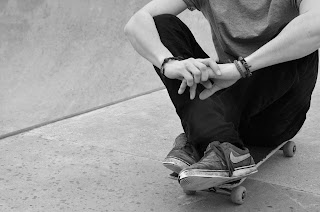Today we had our filming shoots in central London.
We firstly filmed on the Southbank at the skatepark, in recording the skaters in observational style. We also recorded two interviews, firstly with a father and son who gave contrasting ideas about skateboarding culture. This was useful as it shows the tension between those who skate and those who don't, which relates to the brief (self and other). We decided to use these subjects as they were standing watching the skateboarders and appeared to have an interest. However since we were so close to the action, it was hard to hear what they had to say, and probably didn't record very well.
We also recorded an interview with a woman from California and her British nephew. They were both in favour of skateboarding, but had different perspectives due to being from different locations. The nephew used to be a skater himself, but claimed it was harder to find places to skate as he got older. We filmed this interview further away from where the skaters were in order to hear their voices clearer. The downside was that it was quite sunny where we were stood.




We then filmed inside House of Vans. As soon as we arrived we were greeted by 11-year-old Patrick, who showed us around the entire venue, whilst providing details about Vans and his own experiences of the venue. We recorded him as he gave us a tour. We also recorded fill shots of the venue, and various skaters that were about. We then recorded a formal interview with Patrick and his friend Lucian. They mostly spoke about their love for skateboarding and why they do it. I wasn't able to ask them some of the deeper questions that I'd asked other interviewees, such as those regarding drugs, since they were too young. I still think that these interviews were useful to show the contrast between skaters of different ages. I collected both their email addresses and their parents' email addresses so that I could send them release forms.

Finally we recorded some extra fill shots down Leake Street, which is completely covered in graffiti, which has strong connotations to skate culture. There were some skaters around that we filmed and other people who were spray painting.
In general I think this was a successful day of filming, since we got a range of different perspectives.































